INTRO
REGION
LINKS
SHOPS
EVENTS
|
|
HOME INTRO |
VISIT REGION |
MEDIA LINKS |
TOUR SHOPS |
NEWS EVENTS |
|---|---|---|---|---|---|
EBT Fall Spectacular 1998 / FEBT 16th Reunion | |||||
< Back to the EBTRR Homepage
< Back to the EBTRR Multimedia Archive
Page Contents:
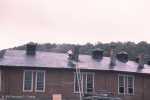 Repairs of the smokejack that
burned in June are nearly complete.
Repairs of the smokejack that
burned in June are nearly complete.
 The Silver Sightseer and two trailers are parked in front of
Orbisonia Station. They have likely
finished an inspection run earlier in the day.
The Silver Sightseer and two trailers are parked in front of
Orbisonia Station. They have likely
finished an inspection run earlier in the day.
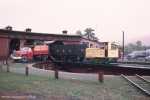 #15 had sprung a smokebox leak the weekend before. Here M-4 has pulled her out
and blocks of wood are being loaded into her smokebox and firebox. Someone
with a box camera is photographing the action.
#15 had sprung a smokebox leak the weekend before. Here M-4 has pulled her out
and blocks of wood are being loaded into her smokebox and firebox. Someone
with a box camera is photographing the action.
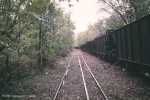 Clearing in the Mount Union Yard
has made the main accessible. The trees were cut in preparation for the use of the
track by the Mount Union Central Railroad, which
is leasing them from the EBT.
Clearing in the Mount Union Yard
has made the main accessible. The trees were cut in preparation for the use of the
track by the Mount Union Central Railroad, which
is leasing them from the EBT.
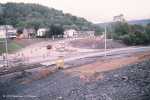 The new 522 bypass dual gauge grade crossing is nearing completion in this photo.
New 522 is to the right while old 522 is in the background. Shirleysburg is to
the left. It is much further along than in
June.
The new 522 bypass dual gauge grade crossing is nearing completion in this photo.
New 522 is to the right while old 522 is in the background. Shirleysburg is to
the left. It is much further along than in
June.
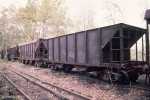 This is one of three remaining 2-bay flat bottomed hoppers in the
Mount Union Yard. It is a modification
of one of the first order of PSCCo cars ordered in 1913. It has different
shaped ribs than the other cars.
This is one of three remaining 2-bay flat bottomed hoppers in the
Mount Union Yard. It is a modification
of one of the first order of PSCCo cars ordered in 1913. It has different
shaped ribs than the other cars.
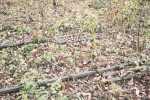 One of the two elusive three way stub switches near the Mount Union
Standard Gauge Scale.
One of the two elusive three way stub switches near the Mount Union
Standard Gauge Scale.
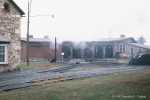 Things at the
Roundhouse are getting
really steamed up!
Things at the
Roundhouse are getting
really steamed up!
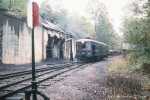 M-1, returning from an inspection of the line, turns at the
Coal Docks.
M-1, returning from an inspection of the line, turns at the
Coal Docks.
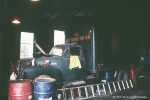 This is one of the EBT's local delivery vans. It is the only one still on the
property and is not used. It is stored in the car barn adjacent to the
Roundhouse.
This is one of the EBT's local delivery vans. It is the only one still on the
property and is not used. It is stored in the car barn adjacent to the
Roundhouse.
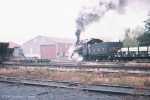 #15 turns after her own inspection tour of the line to test out the flue
sheet repairs made the previous day.
#15 turns after her own inspection tour of the line to test out the flue
sheet repairs made the previous day.
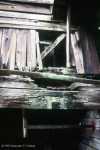 This is one of the beams at the south end of the
Foundry building. It shows how
badly the building needs additional maintenance.
This is one of the beams at the south end of the
Foundry building. It shows how
badly the building needs additional maintenance.
 These are the reservoir ponds on the hillside to the southeast of the yards.
They are supplied by a pump in the
Car Shop from the
Yard Reservoir. The pit in the
foreground appears to be the drain to the yard standpipes.
These are the reservoir ponds on the hillside to the southeast of the yards.
They are supplied by a pump in the
Car Shop from the
Yard Reservoir. The pit in the
foreground appears to be the drain to the yard standpipes.
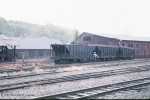 A couple EBT employees are preparing the property for the
spectacular. One is in the hopper trying to cut the tree down with
loppers. The arrival of this chainsaw spelled it's doom. Behind, the
Carpentry Shop has had a
replacement door built just an hour or so before.
A couple EBT employees are preparing the property for the
spectacular. One is in the hopper trying to cut the tree down with
loppers. The arrival of this chainsaw spelled it's doom. Behind, the
Carpentry Shop has had a
replacement door built just an hour or so before.
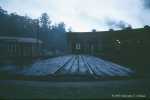 M-7 has her engines fired up and is preparing to head out of the
Roundhouse
onto the Turntable.
M-7 has her engines fired up and is preparing to head out of the
Roundhouse
onto the Turntable.
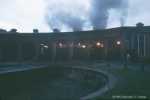 #15 is beaming as she backs out of her
Roundhouse stall
early in the morning.
#15 is beaming as she backs out of her
Roundhouse stall
early in the morning.
![]() This is a stereo video of #17 backing out from the
turntable and giving a final
pair of toots.
42.1 sec., 1.5 MB.
This is a stereo video of #17 backing out from the
turntable and giving a final
pair of toots.
42.1 sec., 1.5 MB.
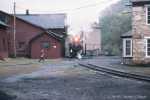 #17 stops for a once-over at the inspection pit before
heading out for service.
#17 stops for a once-over at the inspection pit before
heading out for service.
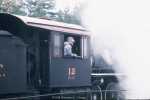 Linn Moedinger takes the throttle of #12 for the
weekend.
Linn Moedinger takes the throttle of #12 for the
weekend.
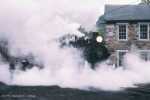 #12 struts her stuff as she pulls away from the
Turntable.
#12 struts her stuff as she pulls away from the
Turntable.
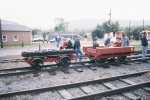 This mysterious MOW car and trailer made a surprise
appearance both days of the Spectacular. The Spider MOW
car did not venture out this year.
This mysterious MOW car and trailer made a surprise
appearance both days of the Spectacular. The Spider MOW
car did not venture out this year.
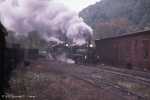 #12 and #15 steam past the
Car Shop with the Shade Gap Picnic Train.
#12 and #15 steam past the
Car Shop with the Shade Gap Picnic Train.
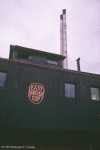 Caboose #28 waits for service beneath the twin stacks
of the
Boiler House.
Caboose #28 waits for service beneath the twin stacks
of the
Boiler House.
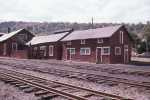 The
Pattern House (left), Air Brake Shop (center) and
Electrical Shop
buildings.
The
Pattern House (left), Air Brake Shop (center) and
Electrical Shop
buildings.
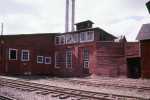 The
Boiler House supplied all the power to the shops
and much of the town.
The
Boiler House supplied all the power to the shops
and much of the town.
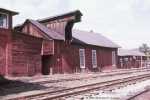 The
Foundry is in better shape than most of the shops
buildings, but has a few nonlinear eccentricities of
its own.
The
Foundry is in better shape than most of the shops
buildings, but has a few nonlinear eccentricities of
its own.
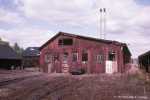 The
Car Shops don't build cars any more, but do keep the
weather off many of them in the off season.
The
Car Shops don't build cars any more, but do keep the
weather off many of them in the off season.
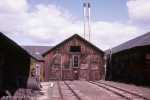 The
Service Bays still see crippled locomotives, though
not so often any more. #14 was rebuilt here in 1987 as
was M-5 a bit later.
The
Service Bays still see crippled locomotives, though
not so often any more. #14 was rebuilt here in 1987 as
was M-5 a bit later.
 The 'Garage' in the
Rockhill Yard stored those miscellaneous items that
did not belong elsewhere. Today the garage houses a few
MOW trailers and other assorted do-dads. To the right is
one of the four guy wire poles for the shop stacks.
The 'Garage' in the
Rockhill Yard stored those miscellaneous items that
did not belong elsewhere. Today the garage houses a few
MOW trailers and other assorted do-dads. To the right is
one of the four guy wire poles for the shop stacks.
 Not the kind of traffic jam one expects to see in the depths
of the Pennsylvania Alleghenys. Three Rockhill Trolley Museum
cars await the turning of #15 on the wye.
Not the kind of traffic jam one expects to see in the depths
of the Pennsylvania Alleghenys. Three Rockhill Trolley Museum
cars await the turning of #15 on the wye.
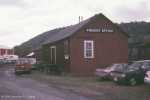 The freight station saw little general merchandise come
through in the later years. Some theorize this might be the
original passenger station in Rockhill.
The freight station saw little general merchandise come
through in the later years. Some theorize this might be the
original passenger station in Rockhill.
 Joseph Kovalchick, owner of the East Broad Top, keeps passengers
in line as #17 and the freight train pull into position. The
American flags are the signal used earlier in the day for the
Whistle Salute.
Joseph Kovalchick, owner of the East Broad Top, keeps passengers
in line as #17 and the freight train pull into position. The
American flags are the signal used earlier in the day for the
Whistle Salute.
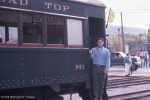 Nathan Kovalchick rides M-1 into the station as the conductor.
Nathan Kovalchick rides M-1 into the station as the conductor.
![]() This is a stereo video of #15 heading up the line along 522
toward the crossing with the Shade Gap Picnic Train. (by Bill Bloomgren)
59.3 sec., 2.2 MB.
This is a stereo video of #15 heading up the line along 522
toward the crossing with the Shade Gap Picnic Train. (by Bill Bloomgren)
59.3 sec., 2.2 MB.
![]() This is a stereo video of #17 heading up the line along 522
toward the crossing with the freight train. (by Bill Bloomgren)
19.2 sec., 0.7 MB.
This is a stereo video of #17 heading up the line along 522
toward the crossing with the freight train. (by Bill Bloomgren)
19.2 sec., 0.7 MB.
![]() This is a stereo video of M-1 heading up the line along 522
toward the crossing. (by Bill Bloomgren)
46.5 sec., 1.7 MB.
This is a stereo video of M-1 heading up the line along 522
toward the crossing. (by Bill Bloomgren)
46.5 sec., 1.7 MB.
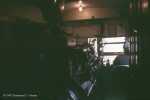 Aboard M-1, this is what one sees looking through the windows
at the front of the baggage compartment.
Aboard M-1, this is what one sees looking through the windows
at the front of the baggage compartment.
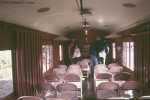 This is the interior of the motorcar M-1's baggage compartment. Everyone
is peering through the windows into the motor/engineer compartment.
This is the interior of the motorcar M-1's baggage compartment. Everyone
is peering through the windows into the motor/engineer compartment.
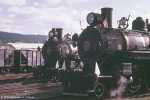 Two sisters await duty. This photo makes clear how to tell
the nearly identical locomotives apart.
Two sisters await duty. This photo makes clear how to tell
the nearly identical locomotives apart.
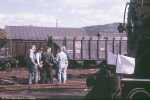 #14 keeps an eye on the hostlers who scheme her next
movement.
#14 keeps an eye on the hostlers who scheme her next
movement.
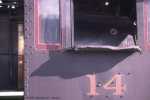 #14 shows that the Mikados do indeed bear the shield herald.
#14 shows that the Mikados do indeed bear the shield herald.
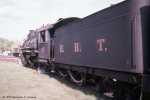 #14 is set and ready for another run down the line.
#14 is set and ready for another run down the line.
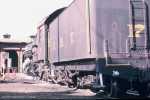 #17 heads back to the stable after a day's work.
#17 heads back to the stable after a day's work.
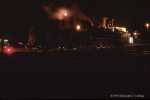 #15 maneuvers near the station to pickup the Shade Gap Picnic
Train for the night run.
#15 maneuvers near the station to pickup the Shade Gap Picnic
Train for the night run.
![]() This is a stereo video riding caboose 28 on the night Shade Gap Picnic
train. The lights to the right were presumably a professional photographer
who paid the railroad to slow the trains down for the shot. Later you can
see #15's steam reflecting the red light from her firebox as the firebox
door is opened. (by Bill Bloomgren)
55.5 sec., 2.1 MB.
This is a stereo video riding caboose 28 on the night Shade Gap Picnic
train. The lights to the right were presumably a professional photographer
who paid the railroad to slow the trains down for the shot. Later you can
see #15's steam reflecting the red light from her firebox as the firebox
door is opened. (by Bill Bloomgren)
55.5 sec., 2.1 MB.
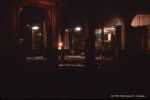 M-1 and #17 wait in the roundhouse for the remaining motive
power to join them.
M-1 and #17 wait in the roundhouse for the remaining motive
power to join them.
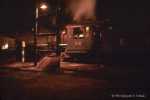 #14 is waiting to be put away after the night train.
#14 is waiting to be put away after the night train.
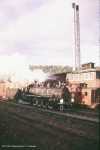 Up and at 'em, #15 heads out for duty.
Up and at 'em, #15 heads out for duty.
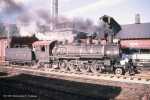 #14 passes the Shade Gap Picnic Train to hook up to the Passenger Train.
#14 passes the Shade Gap Picnic Train to hook up to the Passenger Train.
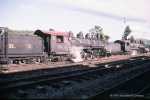 #14 and #15 are at the ready for the next pair of trains.
#14 and #15 are at the ready for the next pair of trains.
 #17 rolls out by the
Boiler House to take the Freight Train out.
#17 rolls out by the
Boiler House to take the Freight Train out.
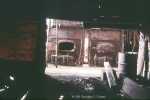 Looking through the coal bunker into the
Boiler House
the two shop boiler doors can be seen.
Looking through the coal bunker into the
Boiler House
the two shop boiler doors can be seen.
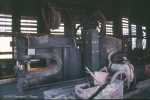 In the
Boiler Shop the large
punch and shear machine stands idle.
In the
Boiler Shop the large
punch and shear machine stands idle.
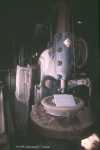 This Niles boring machine in the
Machine Shop
was used to prepare wheels to be mounted back on their axles.
This Niles boring machine in the
Machine Shop
was used to prepare wheels to be mounted back on their axles.
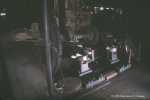 The Locomotive Wheel Lathe in the
Machine Shop
turned the locomotive wheels, or machine the surface that
contacts the rail.
The Locomotive Wheel Lathe in the
Machine Shop
turned the locomotive wheels, or machine the surface that
contacts the rail.
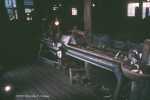 This shot really lit up the life of one of the smaller
Lathes in the
Machine Shop.
This shot really lit up the life of one of the smaller
Lathes in the
Machine Shop.
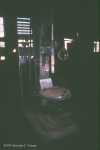 This is the Drill Press in the
Machine Shop.
This is the Drill Press in the
Machine Shop.
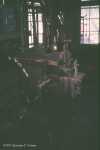 This is the Cutting Tool in the
Machine Shop.
This is the Cutting Tool in the
Machine Shop.
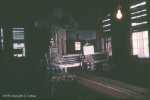 This massive Planer in the
Machine Shop was used to shape
rail for switch points among other things.
This massive Planer in the
Machine Shop was used to shape
rail for switch points among other things.
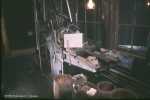 What holds a railroad together? (besides rivets and nails) Bolts! and they
came from this Bolt Maker in the
Machine Shop.
What holds a railroad together? (besides rivets and nails) Bolts! and they
came from this Bolt Maker in the
Machine Shop.
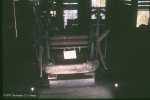 For lighter steel bending duties this
Hand Roll in the
Boiler Shop did the trick.
For lighter steel bending duties this
Hand Roll in the
Boiler Shop did the trick.
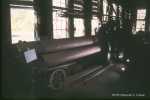 For heavier work this
Power Roll in the
Boiler Shop
was necessary.
For heavier work this
Power Roll in the
Boiler Shop
was necessary.
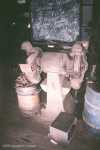 This Double Grinder is in the
Boiler Shop.
This Double Grinder is in the
Boiler Shop.
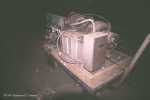 This Electric Welder is one of
two in the Boiler Shop. The EBT
was an early user of electric welding, as demonstrated by the age of this
machine.
This Electric Welder is one of
two in the Boiler Shop. The EBT
was an early user of electric welding, as demonstrated by the age of this
machine.
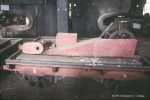 This is one of two unrestored gasoline powered Maintenance-of-Way cars in the
Boiler Shop. At least three more,
two of which are restored, reside on the premises.
This is one of two unrestored gasoline powered Maintenance-of-Way cars in the
Boiler Shop. At least three more,
two of which are restored, reside on the premises.
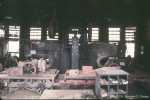 This Punch and Shear Machine is
the largest machine in the shops. In front of it are two unrestored gasoline
MOW crew cars.
This Punch and Shear Machine is
the largest machine in the shops. In front of it are two unrestored gasoline
MOW crew cars.
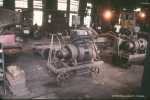 This is an overall shot of the east end of the
Boiler Shop. You can see one
Welding Machine in the foreground.
This is an overall shot of the east end of the
Boiler Shop. You can see one
Welding Machine in the foreground.
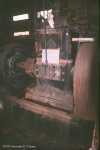 In a wing off the Boiler House,
this Generator provided DC power to
the shops and homes.
In a wing off the Boiler House,
this Generator provided DC power to
the shops and homes.
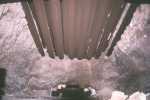 This is the interior of the east
boiler. The water flowed through the pipes above to be heated.
This is the interior of the east
boiler. The water flowed through the pipes above to be heated.
 This Wheel Press machine was used to
assemble and disassemble wheel sets.
This Wheel Press machine was used to
assemble and disassemble wheel sets.
 This is another shot of the
Cutting Tool in the
Machine Shop.
This is another shot of the
Cutting Tool in the
Machine Shop.
 In the far corner of the Machine Shop
this machine performs Bolt Threading.
In the far corner of the Machine Shop
this machine performs Bolt Threading.
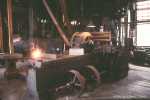 This is a great shot of the
Small Planer in the Machine Shop.
The Motor was used in the 1960's to power the line shafts.
This is a great shot of the
Small Planer in the Machine Shop.
The Motor was used in the 1960's to power the line shafts.
 These are the aforementioned line shafts. Each belt transferred power either
from one shaft to another or from a shaft to a machine.
These are the aforementioned line shafts. Each belt transferred power either
from one shaft to another or from a shaft to a machine.
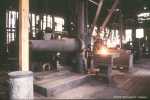 This huge Boring Machine
in the Machine Shop featured
a radial arm.
This huge Boring Machine
in the Machine Shop featured
a radial arm.
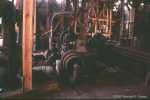 In the center is the Axle Lathe.
To the left is the Wheel Press and
to the right is another small Lathe.
In the center is the Axle Lathe.
To the left is the Wheel Press and
to the right is another small Lathe.
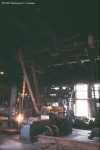 Here's another shot of the
Small Planer in the Machine Shop.
You can see the belt reaching the line shaft.
Here's another shot of the
Small Planer in the Machine Shop.
You can see the belt reaching the line shaft.
 This shot shows the belts and shafts above the
Large Planer in the Machine Shop.
This shot shows the belts and shafts above the
Large Planer in the Machine Shop.
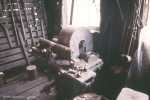 Yet another
Grinder awaits use.
Yet another
Grinder awaits use.
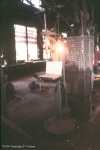 This small Drill Press is in the
rear of the shops.
This small Drill Press is in the
rear of the shops.
 One of the many Lathes basks in the
Machine Shop sunlight.
One of the many Lathes basks in the
Machine Shop sunlight.
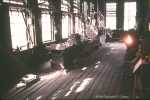 One of the many Lathes basks in the
Machine Shop sunlight.
One of the many Lathes basks in the
Machine Shop sunlight.
![]() This is a stereo video of #12 whistling and passing under
McMullins Summit bridge.
14.2 sec., 0.5 MB.
This is a stereo video of #12 whistling and passing under
McMullins Summit bridge.
14.2 sec., 0.5 MB.
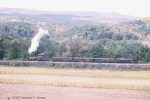 #14 and the passenger train pass over the Long Fill
on the way back to Rockhill Furnace.
#14 and the passenger train pass over the Long Fill
on the way back to Rockhill Furnace.
 On the Thousand Steps tour up Jacks Mountain, we saw the quarry
enginehouse. These workings supplied Harbison Walker
with gannister.
On the Thousand Steps tour up Jacks Mountain, we saw the quarry
enginehouse. These workings supplied Harbison Walker
with gannister.
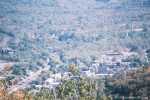 From atop Jacks Mountain one gets a spectacular view of
Mount Union. In the right center of
the photo you can just make out the EBT
Mount Union Yard.
From atop Jacks Mountain one gets a spectacular view of
Mount Union. In the right center of
the photo you can just make out the EBT
Mount Union Yard.
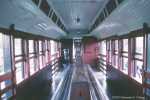 Back at Rockhill Furnace now, this is the
interior of combine #14 after the last train of the spectacular.
Back at Rockhill Furnace now, this is the
interior of combine #14 after the last train of the spectacular.
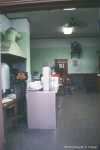 This is the seldom seen interior of the Baggage Room of
Orbisonia Station.
This is the seldom seen interior of the Baggage Room of
Orbisonia Station.
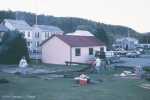 The boy scouts are closing up beside the
Garage.
The boy scouts are closing up beside the
Garage.
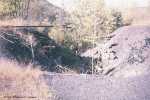 This is the 'Refuse Dump'.
This is the 'Refuse Dump'.
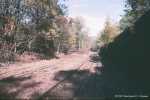 Work is progressing on the clearing of track in the
Mount Union Yard in preparation
for Mount Union Central operations.
Work is progressing on the clearing of track in the
Mount Union Yard in preparation
for Mount Union Central operations.
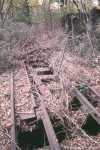 The Mount Union Standard Gauge Scale
is the only one still intact on the EBT.
The Mount Union Standard Gauge Scale
is the only one still intact on the EBT.
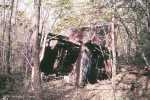 Part of the Coal Transfer Plant,
this building likely housed water pumping and purification facilities.
Part of the Coal Transfer Plant,
this building likely housed water pumping and purification facilities.
 This is the main in the yard looking south. In the distance hoppers are seen
in the South Narrow Gauge Yard.
To the left would have been the coal unloading facility and to the right
the Narrow Gauge Scale.
This is the main in the yard looking south. In the distance hoppers are seen
in the South Narrow Gauge Yard.
To the left would have been the coal unloading facility and to the right
the Narrow Gauge Scale.
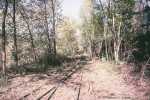 Looking now in the opposite direction we see the track coming in from
the Timber Transfer.
Looking now in the opposite direction we see the track coming in from
the Timber Transfer.
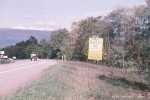 At Adams, the
Riverview Business Center promises
rail service. Soon it will be able to deliver.
At Adams, the
Riverview Business Center promises
rail service. Soon it will be able to deliver.
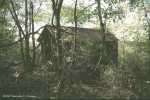 The Shirleysburg Section House
is in the best shape of any on the line.
The Shirleysburg Section House
is in the best shape of any on the line.
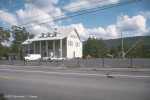 The Markle House served as the
residence for the EBT President. It is now an American Legion post.
The Markle House served as the
residence for the EBT President. It is now an American Legion post.
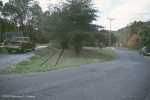 Within the thriving metropolis of Pogue,
the EBT Pogue Passing Siding provided
trains an opportunity to wait for another train before attacking the
Jordan Summit grade.
Within the thriving metropolis of Pogue,
the EBT Pogue Passing Siding provided
trains an opportunity to wait for another train before attacking the
Jordan Summit grade.
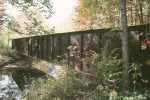 Kylers Bridge reflects in this typically
serene portion of Three Springs Creek.
Kylers Bridge reflects in this typically
serene portion of Three Springs Creek.
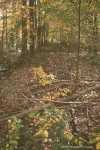 In the underbrush the operating south point of the
Saltillo Wye rests.
In the underbrush the operating south point of the
Saltillo Wye rests.
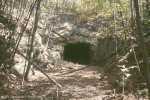 In the mountains now,
Sideling Hill Tunnels south portal awaits the next train.
In the mountains now,
Sideling Hill Tunnels south portal awaits the next train.
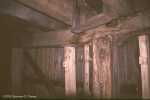 Inside Coles Tankhouse
the reason for the buildings distress is obvious. The reinforcement
posts are the result of 'guerella restoration'.
Inside Coles Tankhouse
the reason for the buildings distress is obvious. The reinforcement
posts are the result of 'guerella restoration'.
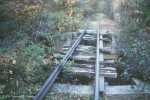 Southmost on the EBT, Woodvale Bridge
is the only one made of solid I-beams rather than riveted girders.
Southmost on the EBT, Woodvale Bridge
is the only one made of solid I-beams rather than riveted girders.
|
HOME |
The East Broad Top Railroad Homepage © 1994-2003 Christopher D. Coleman All rights reserved Site Information Top of this page |
|---|